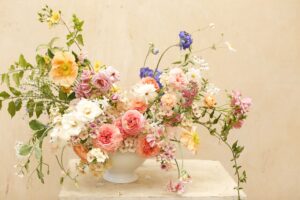
Beyond the Bouquet: Exploring the World of Floral Design – Flowers have been cherished throughout history for their beauty, fragrance, and ability to convey emotions. While bouquets are a popular way to enjoy flowers, there is an art form that takes floral creativity to the next level—floral design. In this article, we’ll explore the fascinating world of floral design, which goes beyond traditional arrangements to create captivating and innovative displays.
The Artistry of Floral Design
Floral design is an art form that combines horticultural skill with artistic flair. It involves the arrangement and presentation of flowers and other botanical elements in a way that is visually pleasing and emotionally expressive. Floral designers, often referred to as florists, use their creativity and knowledge of plant materials to craft unique and captivating compositions.
Beyond Bouquets: Types of Floral Design
- Wedding Floral Design: Wedding bouquets are just one aspect of wedding floral design. Florists also create stunning floral arrangements for ceremonies, receptions, and bridal party attire, turning weddings into blooming celebrations.
- Event and Corporate Floral Design: Floral designers play a crucial role in decorating events such as parties, galas, and corporate gatherings. Their creations set the mood and enhance the ambiance of these occasions.
- Sympathy and Funeral Floral Design: Compassionate floral designers create arrangements that offer solace and support during times of grief and loss. Funeral floral designs convey messages of sympathy and remembrance.
- Home and Interior Floral Design: Floral designers bring the beauty of nature indoors by creating arrangements for homes, offices, and public spaces. These designs enhance interior décor and create a sense of tranquility.
- Artistic Floral Design: Some floral designers take a more avant-garde approach, creating artistic and experimental floral installations that challenge traditional norms and push the boundaries of creativity.
The Creative Process
Floral design is not merely about arranging flowers; it’s a process that involves several essential steps:
- Selection: Florists carefully choose the right flowers and foliage based on color, texture, shape, and seasonal availability.
- Composition: Creating a balanced and harmonious arrangement involves considering design principles such as balance, contrast, proportion, and focal points.
- Technique: Florists use various techniques like wiring, taping, and sculpting to manipulate flowers and create desired shapes and structures.
- Vessel Choice: The choice of container or vessel is crucial, as it complements the design and affects the overall presentation.
- Care and Maintenance: Floral designers ensure that the arrangements remain fresh and vibrant for as long as possible by providing proper care and hydration to the flowers.
Sustainability in Floral Design
In recent years, there has been a growing emphasis on sustainable practices in the floral design industry. Eco-conscious florists prioritize locally sourced and seasonal flowers, minimize waste, and reduce the environmental impact of floral design Trends.
Floral Design as an Art Form
Floral design is more than just a decorative element; it’s a means of artistic expression. Floral designers have the ability to evoke emotions, tell stories, and capture the essence of nature in their creations. Beyond the bouquet, floral design invites us to appreciate the intricate beauty of flowers and the boundless creativity of those who arrange them.
Whether it’s a wedding centerpiece, a sympathy arrangement, or an elaborate floral installation, floral design brings the beauty of the natural world into our lives and enriches our surroundings with the ephemeral splendor of flowers.
